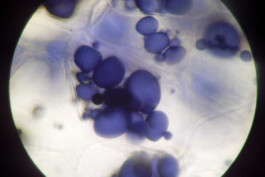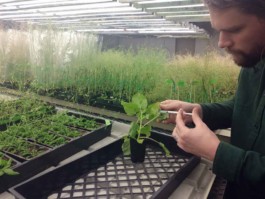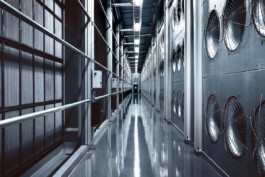
Living, Eternal
Archives
The idea of data being alive, living across generations, has been a core component of human history. Human beings have found ways to record their presence, their way of life, their stories through oral tradition, paintings, carvings, and monuments. In the modern era, with the rise of information technology and the Internet, we are constantly in the act of capturing and recording culture in a seamless way.
This shift towards digital data has led to a surge in innovation, creating a high degree of flexibility and convenience. This in turn leads to an accumulation of digital data resulting in the need for the proliferation of cloud based services to manage and host the enormous amount of data each human produces. However, these systems are not designed for long-term data storage. Servers are replaced every 5 years, creating waste. Formats, software and hardware evolve over time and grow obsolete.
As a designer and technologist, I am interested in how we could design pathways for types of data storage that could essentially live forever. It seems I’m not alone. Synthetic DNA and digital DNA data storage has received large amounts of funding and attention as the next big storage technology, largely on the basis of technical possibilities. Meanwhile, in vivo, or living DNA data storage remains a speculative option(1). Data stored on living cells necessarily must grow and mutate(2). Synthetic DNA, on the other hand, is isolated, static, and stable. It does not change over time.
Yet, my curiosity is piqued by the unique qualities and richness that storing data in vivo can offer. I believe that possibilities and applications which harness the properties of living data storage can enrich the user experience in inimitable ways compared with other formats. In my work on Grow Your Own Cloud, I propose a new model for digital data storage within the DNA of plants, trees and other carbon absorbing organisms. The vision is to inspire the creation of worlds in which people might imagine alternative ways of interacting with technology, data and the living systems we are part of.
Since data stored in DNA will likely never compete with the read/write speeds of digital systems, it is safe to assume in all likelihood that the best applications for DNA data storage are around data archival. The question that starts to arise then is what should be archived and how might this be achieved? One of the ideas that I keep coming back to in my work is the notion of a Living Archive.

Living Archives
The term Living Archive has previously been used to describe an evolving archive that changes over time. I have explored this in Bodies of Knowledge, where people could access a museum’s dance archives by performing gestures to a camera in an exhibition space. Machine learning algorithms would then record their movements and playback the nearest possible dance from the archives. This is a more traditional spin on the idea of a Living Archive.
What I imagine now instead however, is something more literal. An archive that is alive. That utilises living organisms to house data objects. A space which works with living in vivo DNA data storage as part of a natural ecosystem. Living archives could be a way of giving life to the past and enabling current and future generations to appreciate and interact with living heritage. This might take various forms, to resemble something like the proverbial microbial ooze, or even a Data Forest. In fact it creates numerous novel typologies combining aspects of living and built systems.
Living Archives would utilise DNA data storage to create a form of data archival that could work with living organisms. This I imagine would be an ecosystem composed of organisms such as bacteria, fungi and plants. This ecosystem would preserve and maintain digital data across generations, meaning that data could live on for thousands of years and potentially even longer depending on how the selected species evolve and handle changing planetary conditions. In essence it creates the possibility for data to live forever, a concept I refer to as data immortality.

DNA Data Storage
The reason that DNA data storage is considered to be so promising for long term data archival is typically its high density compared with other information storage formats. Proponents of DNA data storage claim a single gram of synthetic DNA could store 215 petabytes of information(4), which leads to the claim that we might be able to store all of the world’s data in the back of a van(5) However, rather than focusing on theoretical capacity limits or technical possibilities, I champion the quality of experience and value that can be derived through interactions with living systems.
The basis of this notion comes from my research into in vivo DNA data storage. As the technology is still very early it is important to explain how it works. Digital data is typically represented as binary bits. These bits can be translated into DNA bases (A, T, G, and C), and represented as a string of DNA. Synthetic DNA can then be synthesised so that the digital data it represents is stored in molecular form(5). This DNA can be introduced into a living organism (e-coli, tobacco plants)(6) where it is maintained inside the organism, along with its own native genomic DNA. To read the data back out, a sample can be collected, the DNA sequenced and decoded back into binary bits.
The introduction of new technologies (e.g. CRISPR-Based technologies) and the emergence of synthetic biology has made it possible to allow precise data storage within living systems. This can unlock many potential opportunities, while also raising a host of ethical considerations that must be addressed prior to the deployment of such powerful technologies.
While all the attention is on DNA data storage within synthetic DNA, working with living data storage brings up new tensions and questions.

1. What if preservation was constantly changing, evolving and growing with the passage of time?
Preservation has typically been something seen as a static act, but living data storage would provide a dynamic approach to preserving our digital records. A more dynamic, living mechanism for capturing stories and memories, might inspire new ideas and challenge the boundaries of what preservation is and what it can be. The potential of DNA to store multiple forms of data could also be an invaluable asset to our society, particularly with regard to heritage. Imagine archives rich in audiovisual data, but also scents and tastes. Archives that capture the ephemeral in a transient manner.
Cultivating our heritage in this way could also provide a more ecological way of preserving information and culture. The living systems work in harmony with the planet’s natural cycles and thus data systems working in this way would also be more attuned to a natural rhythm. In this way, we could create a more holistic view of our history and future, while having living data storage form the backbone of an ecologically responsible collective consciousness.
Shifting towards this type of approach would also shift our perspective away from an anthropomorphic experience. With data treated as a commodity, and data storage as a problem to be solved (8), what if instead we take a more-than-human perspective, looking beyond functional or technical, towards aesthetic, sensorial and emotional qualities.


2. What are the spatial and experiential qualities of a habitat that stores data with living organisms?
While traditional data storage facilities seek to maintain stability and integrity, Living Archives could work with living systems to potentially allow for transformation, or as it is more colloquially known, mutation. This would have the effect of transforming the data and heritage with it. In such a system, dynamic conservation strategies could become a way of preserving species and data in adaptation with the ever-changing environment, rather than preventing evolution. Thus, change might become something that is celebrated rather than fought against.
At the same time, the archive would utilise the properties of living systems to provide a resilient infrastructure for heritage. In this way linkages between heritage and the nurture and growth of living organisms would emerge, in juxtaposition to today’s systems for digital data archival which lead to the depletion of scarce natural resources and a heavy dependence on energy. The archive would be a living system, drawing the archive together around a central repository, or organism. It would be managed through a culture of collaboration and interdependence, where organisms (archival entities) are linked together.
Through this, the archive would be able to respond dynamically to changing conditions and actively sense, remember, and respond to its environment. In this way, the archive would be more resilient to shocks, improve access to heritage, and remain relevant and useful to communities for generations.

3. How might new processes for tending to data emerge such as data cultivation and how might such processes affect relationships between organisms?
When thinking about organism based data archival and its relation to heritage, aspects of culture become nature and nature supports and carries culture. I am interested in what that shift means for institutions and the public, highlighting critical questions around heritage; what is the future of heritage as we move toward more tech solutions, and how do new materialities of storage define political and social aspects of interactions with heritage objects?(9)
The particular qualities of in vivo data storage might also be translated into new archival processes for heritage In particular the user journey and interfaces would lead to novel affordances emerging from breakthroughs in synthetic biology to create entirely new ways of interacting with data. Working with biology as technology provides closer proximity to working with nature. It implies slowness as a quality and patience as a virtue over the notion of real-time. Through this opportunities for fresh biological computing interfaces and user behaviours emerge, which would likely be in juxtaposition to conventional computational technological systems.
With regards to living archives it would be crucial to think about who and what would be required to sustain such infrastructure, establishing ways for people to participate in heritage cultivation, beyond digital media and screens. What kinds of new jobs might be created? How is such infrastructure funded, organised or governed? Models such as DAOs offer interesting clues as to how a decentralised governance model might be applied to allow a large group of people to cooperate and coordinate for the upkeep and maintenance of a living archive.
Of course, there are enormous challenges that would be faced with regard to bioengineering and the state of the art is extremely immature. However, it would be compelling to grow and challenge the technology alongside challenging perceptions of archiving and heritage. Culturally we as human beings see archival as a static preservation activity, whereas this approach is from a theoretical aspect of evolving heritage within a living being. This is a shift that will require thoughtful and open collaboration as perhaps more than anything archiving within the emergent properties of living systems rather than fighting against them, is a rather radical idea.
In addition, ethical and legal questions are important to be addressed. Many countries have laws about genetic modification and the liabilities such modifications may invoke. Furthermore, issues of privacy and access to data stored within living organisms must be considered and designed within sensitive frameworks. If a system is designed to store sensitive data within organisms, what measures will be taken to protect this data and who would manage this?
Finally, as for the hosts themselves, what is really in it for them? As a species we are wonderfully adept at utilising the resources of the planet, however living archives offer an opportunity to rethink how these relationships work. Can we build a non-extractive model that provides a compelling case for the other organisms to cooperate with us? While it will be difficult to ascertain consent from an Oak tree, finding alignment between the optimal ecological conditions for the multitudes or organisms and our needs to preserve digital records can lead to a mutually beneficial relationship. A new symbiosis.
If such ethical questions can be confidently addressed, the idea of Living Archives can clearly prove to be very beneficial for the planet at large. The possibility for regenerating depleted ecosystems is a major draw. The potential remediation of enormous amounts of carbon dioxide can help to address climate change, while archiving data in this manner would of course also prevent megatonnes of CO2 being released into the atmosphere.
Living archives can also help to create a more mindful and ethical relationship between humans and nature. By participating in the development of living archives, people can learn to respect and appreciate living systems and natural capital. At the same time nature would be given the value it deserves. The idea of living archives thus presents an opportunity for economic, environmental, and social benefits, while being mindful of the need to protect the planet and its ecosystems. If we regard the idea from a long-term, positive externality creating perspective, this approach yields great appeal.
References
1. Yim, S.S., McBee, R.M., Song, A.M. et al. (2021) Robust direct digital-to-biological data storage in living cells. Nat Chem Biol 17, 246–253. https://doi.org/10.1038/s41589-020-00711-4
2. Ceze, L., Nivala, J. and Strauss, K. (2019) “Molecular digital data storage using DNA,” Nature Reviews Genetics, 20(8), pp. 456–466. Available at: https://doi.org/10.1038/s41576-019-0125-3.
3. Meiser, L.C., Antkowiak, P.L., Koch, J. et al. (2020) Reading and writing digital data in DNA. Nat Protoc 15, 86–10. https://doi.org/10.1038/s41596-019-0244-5
4. Erlich, Y. and Zielinski, D. (2017) DNA fountain enables a robust and efficient storage architecture, science.org. Available: https://www.science.org/doi/10.1126/science.aaj2038
5. Ceze, L., Nivala, J. and Strauss, K. (2019) “Molecular digital data storage using DNA,” Nature Reviews Genetics, 20(8), pp. 456–466. Available at: https://doi.org/10.1038/s41576-019-0125-3.
6. Fister K., Fister I., Murovec J. The Potential of Plants and Seeds in DNA-Based Information Storage. In: Schuster A. (eds) Understanding Information. Advanced Information and Knowledge Processing. Springer, Cham. https://doi.org/10.1007/978-3-319-59090-5_4 (2017)
7. Mayer-Schönberger, Viktor. (2011) Delete: The virtue of forgetting in the digital age. Princeton University Press
8. Burdick, Anne, et al. Digital_Humanities. Mit Press, (2012).
9. Harrison, Rodney (2013) "Forgetting to remember, remembering to forget: late modern heritage practices, sustainability and the ‘crisis’ of accumulation of the past." International Journal of Heritage Studies 19.6: 579-595.

Living, Eternal
Archives
The idea of data being alive, living across generations, has been a core component of human history. Human beings have found ways to record their presence, their way of life, their stories through oral tradition, paintings, carvings, and monuments. In the modern era, with the rise of information technology and the Internet, we are constantly in the act of capturing and recording culture in a seamless way.
This shift towards digital data has led to a surge in innovation, creating a high degree of flexibility and convenience. This in turn leads to an accumulation of digital data resulting in the need for the proliferation of cloud based services to manage and host the enormous amount of data each human produces. However, these systems are not designed for long-term data storage. Servers are replaced every 5 years, creating waste. Formats, software and hardware evolve over time and grow obsolete.
As a designer and technologist, I am interested in how we could design pathways for types of data storage that could essentially live forever. It seems I’m not alone. Synthetic DNA and digital DNA data storage has received large amounts of funding and attention as the next big storage technology, largely on the basis of technical possibilities. Meanwhile, in vivo, or living DNA data storage remains a speculative option(1). Data stored on living cells necessarily must grow and mutate(2). Synthetic DNA, on the other hand, is isolated, static, and stable. It does not change over time.
Yet, my curiosity is piqued by the unique qualities and richness that storing data in vivo can offer. I believe that possibilities and applications which harness the properties of living data storage can enrich the user experience in inimitable ways compared with other formats. In my work on Grow Your Own Cloud, I propose a new model for digital data storage within the DNA of plants, trees and other carbon absorbing organisms. The vision is to inspire the creation of worlds in which people might imagine alternative ways of interacting with technology, data and the living systems we are part of.
Since data stored in DNA will likely never compete with the read/write speeds of digital systems, it is safe to assume in all likelihood that the best applications for DNA data storage are around data archival. The question that starts to arise then is what should be archived and how might this be achieved? One of the ideas that I keep coming back to in my work is the notion of a Living Archive.

Living Archives
The term Living Archive has previously been used to describe an evolving archive that changes over time. I have explored this in Bodies of Knowledge, where people could access a museum’s dance archives by performing gestures to a camera in an exhibition space. Machine learning algorithms would then record their movements and playback the nearest possible dance from the archives. This is a more traditional spin on the idea of a Living Archive.
What I imagine now instead however, is something more literal. An archive that is alive. That utilises living organisms to house data objects. A space which works with living in vivo DNA data storage as part of a natural ecosystem. Living archives could be a way of giving life to the past and enabling current and future generations to appreciate and interact with living heritage. This might take various forms, to resemble something like the proverbial microbial ooze, or even a Data Forest. In fact it creates numerous novel typologies combining aspects of living and built systems.
Living Archives would utilise DNA data storage to create a form of data archival that could work with living organisms. This I imagine would be an ecosystem composed of organisms such as bacteria, fungi and plants. This ecosystem would preserve and maintain digital data across generations, meaning that data could live on for thousands of years and potentially even longer depending on how the selected species evolve and handle changing planetary conditions. In essence it creates the possibility for data to live forever, a concept I refer to as data immortality.

DNA Data Storage
The reason that DNA data storage is considered to be so promising for long term data archival is typically its high density compared with other information storage formats. Proponents of DNA data storage claim a single gram of synthetic DNA could store 215 petabytes of information(4), which leads to the claim that we might be able to store all of the world’s data in the back of a van(5) However, rather than focusing on theoretical capacity limits or technical possibilities, I champion the quality of experience and value that can be derived through interactions with living systems.
The basis of this notion comes from my research into in vivo DNA data storage. As the technology is still very early it is important to explain how it works. Digital data is typically represented as binary bits. These bits can be translated into DNA bases (A, T, G, and C), and represented as a string of DNA. Synthetic DNA can then be synthesised so that the digital data it represents is stored in molecular form(5). This DNA can be introduced into a living organism (e-coli, tobacco plants)(6) where it is maintained inside the organism, along with its own native genomic DNA. To read the data back out, a sample can be collected, the DNA sequenced and decoded back into binary bits.
The introduction of new technologies (e.g. CRISPR-Based technologies) and the emergence of synthetic biology has made it possible to allow precise data storage within living systems. This can unlock many potential opportunities, while also raising a host of ethical considerations that must be addressed prior to the deployment of such powerful technologies.
While all the attention is on DNA data storage within synthetic DNA, working with living data storage brings up new tensions and questions.

1. What if preservation was constantly changing, evolving and growing with the passage of time?
Preservation has typically been something seen as a static act, but living data storage would provide a dynamic approach to preserving our digital records. A more dynamic, living mechanism for capturing stories and memories, might inspire new ideas and challenge the boundaries of what preservation is and what it can be. The potential of DNA to store multiple forms of data could also be an invaluable asset to our society, particularly with regard to heritage. Imagine archives rich in audiovisual data, but also scents and tastes. Archives that capture the ephemeral in a transient manner.
Cultivating our heritage in this way could also provide a more ecological way of preserving information and culture. The living systems work in harmony with the planet’s natural cycles and thus data systems working in this way would also be more attuned to a natural rhythm. In this way, we could create a more holistic view of our history and future, while having living data storage form the backbone of an ecologically responsible collective consciousness.
Shifting towards this type of approach would also shift our perspective away from an anthropomorphic experience. With data treated as a commodity, and data storage as a problem to be solved (8), what if instead we take a more-than-human perspective, looking beyond functional or technical, towards aesthetic, sensorial and emotional qualities.

2. What are the spatial and experiential qualities of a habitat that stores data with living organisms?
While traditional data storage facilities seek to maintain stability and integrity, Living Archives could work with living systems to potentially allow for transformation, or as it is more colloquially known, mutation. This would have the effect of transforming the data and heritage with it. In such a system, dynamic conservation strategies could become a way of preserving species and data in adaptation with the ever-changing environment, rather than preventing evolution. Thus, change might become something that is celebrated rather than fought against.
At the same time, the archive would utilise the properties of living systems to provide a resilient infrastructure for heritage. In this way linkages between heritage and the nurture and growth of living organisms would emerge, in juxtaposition to today’s systems for digital data archival which lead to the depletion of scarce natural resources and a heavy dependence on energy. The archive would be a living system, drawing the archive together around a central repository, or organism. It would be managed through a culture of collaboration and interdependence, where organisms (archival entities) are linked together.
Through this, the archive would be able to respond dynamically to changing conditions and actively sense, remember, and respond to its environment. In this way, the archive would be more resilient to shocks, improve access to heritage, and remain relevant and useful to communities for generations.
3. How might new processes for tending to data emerge such as data cultivation and how might such processes affect relationships between organisms?
When thinking about organism based data archival and its relation to heritage, aspects of culture become nature and nature supports and carries culture. I am interested in what that shift means for institutions and the public, highlighting critical questions around heritage; what is the future of heritage as we move toward more tech solutions, and how do new materialities of storage define political and social aspects of interactions with heritage objects?(9)
The particular qualities of in vivo data storage might also be translated into new archival processes for heritage In particular the user journey and interfaces would lead to novel affordances emerging from breakthroughs in synthetic biology to create entirely new ways of interacting with data. Working with biology as technology provides closer proximity to working with nature. It implies slowness as a quality and patience as a virtue over the notion of real-time. Through this opportunities for fresh biological computing interfaces and user behaviours emerge, which would likely be in juxtaposition to conventional computational technological systems.
With regards to living archives it would be crucial to think about who and what would be required to sustain such infrastructure, establishing ways for people to participate in heritage cultivation, beyond digital media and screens. What kinds of new jobs might be created? How is such infrastructure funded, organised or governed? Models such as DAOs offer interesting clues as to how a decentralised governance model might be applied to allow a large group of people to cooperate and coordinate for the upkeep and maintenance of a living archive.
Of course, there are enormous challenges that would be faced with regard to bioengineering and the state of the art is extremely immature. However, it would be compelling to grow and challenge the technology alongside challenging perceptions of archiving and heritage. Culturally we as human beings see archival as a static preservation activity, whereas this approach is from a theoretical aspect of evolving heritage within a living being. This is a shift that will require thoughtful and open collaboration as perhaps more than anything archiving within the emergent properties of living systems rather than fighting against them, is a rather radical idea.
In addition, ethical and legal questions are important to be addressed. Many countries have laws about genetic modification and the liabilities such modifications may invoke. Furthermore, issues of privacy and access to data stored within living organisms must be considered and designed within sensitive frameworks. If a system is designed to store sensitive data within organisms, what measures will be taken to protect this data and who would manage this?
Finally, as for the hosts themselves, what is really in it for them? As a species we are wonderfully adept at utilising the resources of the planet, however living archives offer an opportunity to rethink how these relationships work. Can we build a non-extractive model that provides a compelling case for the other organisms to cooperate with us? While it will be difficult to ascertain consent from an Oak tree, finding alignment between the optimal ecological conditions for the multitudes or organisms and our needs to preserve digital records can lead to a mutually beneficial relationship. A new symbiosis.
If such ethical questions can be confidently addressed, the idea of Living Archives can clearly prove to be very beneficial for the planet at large. The possibility for regenerating depleted ecosystems is a major draw. The potential remediation of enormous amounts of carbon dioxide can help to address climate change, while archiving data in this manner would of course also prevent megatonnes of CO2 being released into the atmosphere.
Living archives can also help to create a more mindful and ethical relationship between humans and nature. By participating in the development of living archives, people can learn to respect and appreciate living systems and natural capital. At the same time nature would be given the value it deserves. The idea of living archives thus presents an opportunity for economic, environmental, and social benefits, while being mindful of the need to protect the planet and its ecosystems. If we regard the idea from a long-term, positive externality creating perspective, this approach yields great appeal.
References
1. Yim, S.S., McBee, R.M., Song, A.M. et al. (2021) Robust direct digital-to-biological data storage in living cells. Nat Chem Biol 17, 246–253. https://doi.org/10.1038/s41589-020-00711-4
2. Ceze, L., Nivala, J. and Strauss, K. (2019) “Molecular digital data storage using DNA,” Nature Reviews Genetics, 20(8), pp. 456–466. Available at: https://doi.org/10.1038/s41576-019-0125-3.
3. Meiser, L.C., Antkowiak, P.L., Koch, J. et al. (2020) Reading and writing digital data in DNA. Nat Protoc 15, 86–10. https://doi.org/10.1038/s41596-019-0244-5
4. Erlich, Y. and Zielinski, D. (2017) DNA fountain enables a robust and efficient storage architecture, science.org. Available: https://www.science.org/doi/10.1126/science.aaj2038
5. Ceze, L., Nivala, J. and Strauss, K. (2019) “Molecular digital data storage using DNA,” Nature Reviews Genetics, 20(8), pp. 456–466. Available at: https://doi.org/10.1038/s41576-019-0125-3.
6. Fister K., Fister I., Murovec J. The Potential of Plants and Seeds in DNA-Based Information Storage. In: Schuster A. (eds) Understanding Information. Advanced Information and Knowledge Processing. Springer, Cham. https://doi.org/10.1007/978-3-319-59090-5_4 (2017)
7. Mayer-Schönberger, Viktor. (2011) Delete: The virtue of forgetting in the digital age. Princeton University Press
8. Burdick, Anne, et al. Digital_Humanities. Mit Press, (2012).
9. Harrison, Rodney (2013) "Forgetting to remember, remembering to forget: late modern heritage practices, sustainability and the ‘crisis’ of accumulation of the past." International Journal of Heritage Studies 19.6: 579-595.